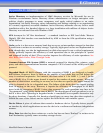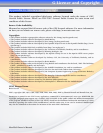
MaxNAS Owner’s Manual
74
of the disks fails, its contents can be retrieved from the duplicate disk. Furthermore, a RAID
1 array can also improve the throughput of read operations by allowing separate reads to be
performed concurrently on the two disks.
RAID 5 A RAID 5 array is similar to a RAID 4 array in that, it utilizes a striped set of three
or more disks with parity of the strips (or chunks) comprising a stripe being assigned to the
disks in the set in a round robin fashion. The figure below illustrates an example of a RAID
5 array comprised of three disks – disks A, B and C. For instance, the strip on disk C marked
as P(1A,1B) contains the parity for the strips 1A and 1B. Similarly the strip on disk A marked
as P(2B,2C) contains the parity for the strips 2B and 2C. Advantage: RAID 5 ensures that if
one of the disks in the striped set fails, its contents can be extracted using the information on
the remaining functioning disks. It has a distinct advantage over RAID 4 when writing since
(unlike RAID 4 where the parity data is written to a single drive) the parity data is distributed
across all drives. Also, a RAID 5 array can improve the throughput of read operations by
allowing reads to be performed concurrently on multiple disks in the set.
RAID 10 A RAID 10 array is formed using a two-layer hierarchy of RAID types. At the lowest
level of the hierarchy are a set of RAID 1 arrays i.e., mirrored sets. These RAID 1 arrays in
turn are then striped to form a RAID 0 array at the upper level of the hierarchy. The collective
result is a RAID 10 array. The figure below demonstrates a RAID 10 comprised of two RAID
1 arrays at the lower level of the hierarchy – arrays A and B. These two arrays in turn are
striped using 4 stripes (comprised of the strips 1A, 1B, 2A, 2B etc.) to form a RAID 0 at the
upper level of the hierarchy. The result is a RAID 10. Advantage: RAID 10 ensures that if one
of the disks in any parity group fails, its contents can be extracted using the information on
the remaining functioning disks in its parity group. Thus it offers better data redundancy
than the simple RAID types such as RAID 1, 3, and 5. Also, a RAID 10 array can improve the
throughput of read operations by allowing reads to be performed concurrently on multiple
disks in the set.
Read Ahead Motivated by the principle of “spatial locality”, many RAID controllers read
blocks of data from secondary storage ahead of time, i.e., before an application actually
requests those blocks. The number of data blocks that are read ahead of time is typically
governed by some heuristic that observes the pattern of requests. The read-ahead technique
is particularly efficient when the spatial distribution of an application’s requests follows a
sequential pattern.
RAID Rebuild When a RAID array enters into a degraded mode, it is advisable to rebuild the
array and return it to its original configuration (in terms of the number and state of working
disks) to ensure against operation in degraded mode
SATA Acronym for “Serial ATA”. A hard disk drive interface standard developed to enhance
connectivity and speed over the IDE, or Parallel ATA disk interface. Current generation SATAII
supports speeds up to 300MB/S.
SCSI This is an acronym for “Small Computer System Interface”. It is a high-speed parallel
communication scheme permitting data transfer rates of up to 320 MB/sec using the Ultra320
specification. The current specification supports up to 15 devices per channel with domain
validation and CRC error checking on all transferred data.
E-Glossary


















